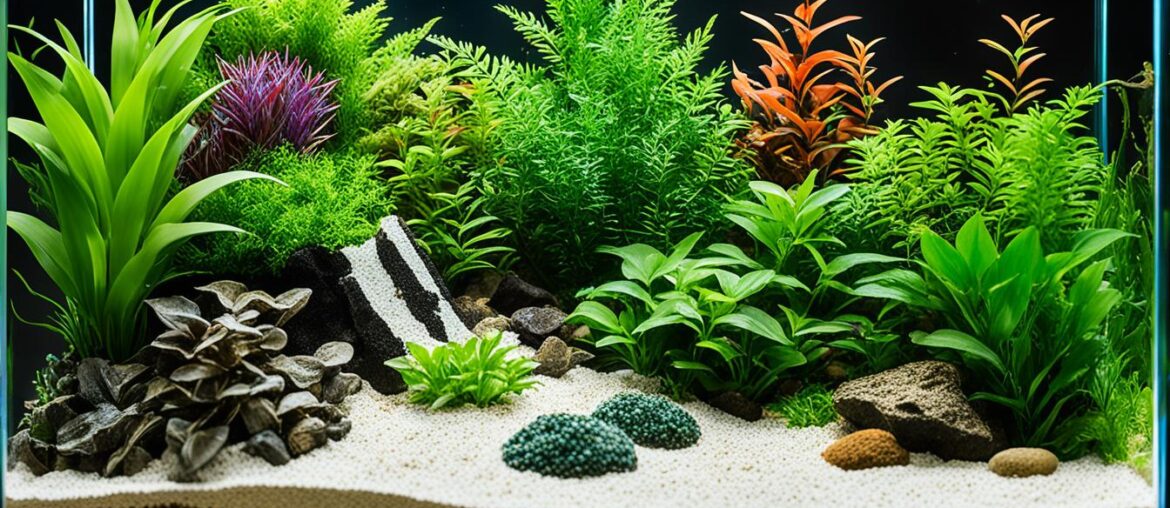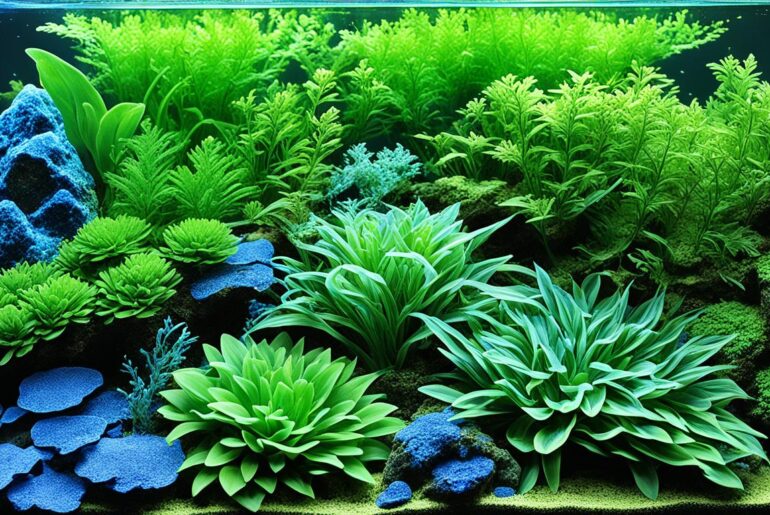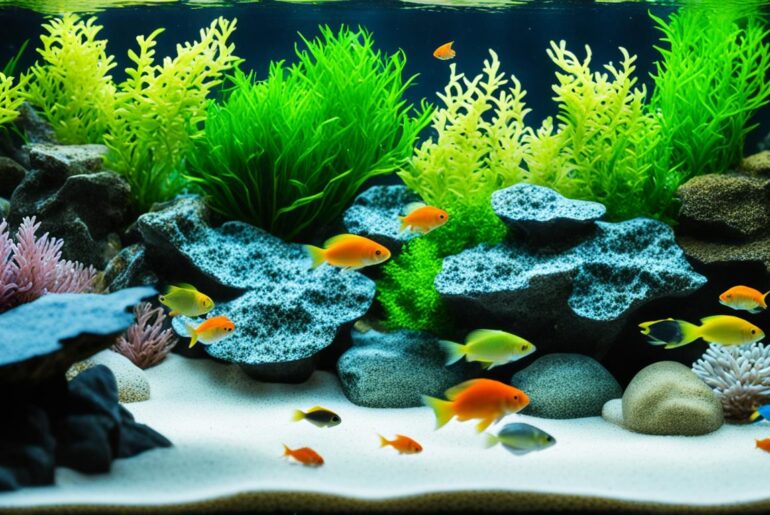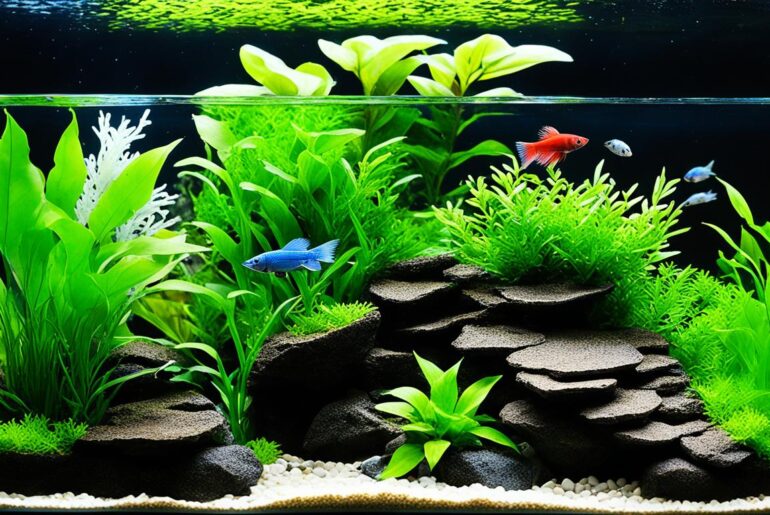Have you ever peered into a freshwater aquarium and felt captivated by the vibrant aquatic plants and colorful fish swimming gracefully? It’s a scene that can instantly transport you to a serene and mesmerizing underwater world. As an avid aquarium enthusiast myself, I’ve spent countless hours perfecting the art of creating a thriving aquatic ecosystem. And let me tell you, one of the keys to achieving that natural beauty lies in customizing the ideal substrate mix for your freshwater aquarium.
The substrate, or the ground covering at the bottom of the tank, is not just a decorative element, but an essential foundation for plant growth and the overall health of your aquatic inhabitants. It’s like the soil in a garden, providing the nutrients, stability, and anchoring that plants need to flourish.
But finding the best substrate for your freshwater aquarium can be overwhelming. There are so many options to choose from – nutrient-rich substrates, inert substrates, gravel, sand, and more. Which one is right for your tank? How do you ensure that it supports the growth of your plants?
In this comprehensive guide, I’ll walk you through everything you need to know about customizing substrate mixes for freshwater aquariums. From understanding the importance of substrate for planted tanks to exploring the pros and cons of different substrate types, we’ll cover it all. Get ready to unlock the secrets of creating an aquatic paradise right in your own home!
Key Takeaways:
- Choosing the right substrate is crucial for the growth of aquatic plants in your freshwater aquarium.
- There are two main types of substates – nutrient-rich and inert – each with its own benefits and considerations.
- Nutrient-rich substrates provide essential nutrients for plant growth but may require remineralization over time.
- Inert substrates like gravel and sand do not provide nutrients but can still be used effectively with the use of root tabs or liquid fertilizers.
- Mixing substrates and exploring cost-effective alternatives can help you customize the perfect substrate mix for your aquarium.
Understanding the Importance of Substrate for Planted Tanks
Substrate is an essential element in the success of a planted tank in freshwater aquariums. It serves as a foundation for aquatic plants, allowing them to anchor their roots and absorb vital nutrients. Different plants have different strategies for nutrient absorption, with some relying on their roots while others primarily absorb nutrients from the water column. Therefore, choosing the right substrate is crucial and should be based on the specific needs of the plants you intend to keep.
For root-feeding plants, such as Amazon sword (Echinodorus species) or dwarf hairgrass (Eleocharis parvula), nutrient-rich substrates are highly beneficial. These substrates, like ADA Aqua Soil and Seachem Flourite, provide a continuous supply of essential nutrients, promoting healthy root development and robust plant growth.
On the other hand, some plants, like water sprite (Ceratopteris thalictroides) or anacharis (Elodea genus), primarily absorb nutrients through their leaves and stems. For these plants, inert substrates, such as gravel or sand, can be used effectively. While inert substrates do not provide nutrients themselves, they can still support plant growth by using root tabs or liquid fertilizers to supplement the water column.
Understanding the importance of substrate in supporting plant growth is key to creating a thriving planted tank. It allows you to customize an ideal substrate mix that caters to the nutrient absorption strategies of your chosen plants, ensuring they receive the necessary elements for healthy growth and development.
“Choosing the right substrate is like laying a strong foundation for a beautiful garden in a freshwater aquarium. It sets the stage for lush plant growth and vibrant aquatic landscapes.” – Experienced Aquarist
Pros and Cons of Nutrient-Rich Substrates
Nutrient-rich substrates like ADA Aqua Soil and Aquavitro Aquasolum offer numerous benefits for planted aquariums. These substrates contain organic materials that deliver essential nutrients, promoting healthy plant growth. Additionally, they can lower the pH and soften water hardness, creating optimal conditions for aquatic plants to thrive. Nutrient-rich substrates are particularly advantageous for crystal shrimp tanks and aquariums housing heavy root feeders.
However, there are some drawbacks to consider. Over time, nutrient-rich substrates can become depleted, necessitating remineralization to replenish the nutrients. Furthermore, these substrates have the potential to break down, resulting in muddy substrates and cloudy water. Another factor to consider is the cost. Nutrient-rich substrates tend to be more expensive compared to inert substrates, making them less cost-effective for some aquarium owners.
Despite the disadvantages, the benefits of nutrient-rich substrates make them a popular choice for many planted aquarium enthusiasts. By carefully considering the specific needs of your aquarium and balancing the pros and cons, you can determine if nutrient-rich substrates are the right choice for your freshwater aquarium.
Benefits of Inert Substrates
Inert substrates, such as gravel and sand, provide several benefits for freshwater aquariums. While they do not directly provide nutrients for plants, they still serve as a medium for anchoring plants and creating an attractive substrate.
Inert substrates like CaribSea Eco-Complete and Seachem Flourite are long-lasting and do not break down over time, eliminating the need for frequent replacement. These substrates are typically made of volcanic or clay-based gravel, which has a higher cation exchange capacity (CEC).
The higher CEC of inert substrates allows them to hold onto nutrients from fish waste or fertilizers, making them available for plant uptake. This promotes healthy plant growth and ensures that essential nutrients are not lost into the water column.
Inert substrates have minimal impact on water parameters such as pH and hardness, providing a stable environment for both fish and plants.
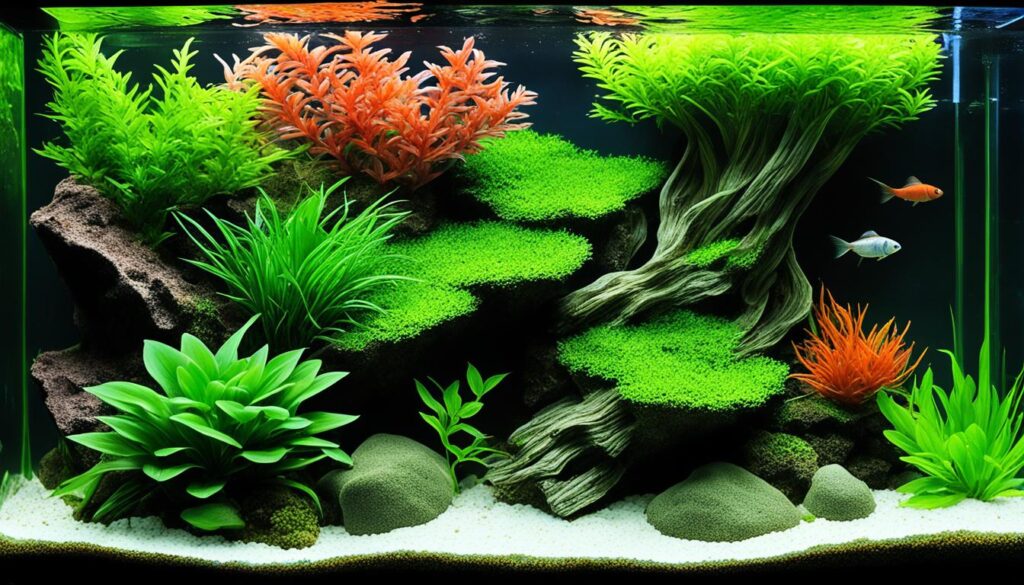
“Inert substrates like gravel and sand provide a natural and visually pleasing foundation for plants in freshwater aquariums.”
Comparison of Inert Substrates
Here is a comparison of popular inert substrates for freshwater aquariums:
| Substrate | Features | Benefits |
|---|---|---|
| CaribSea Eco-Complete | Volcanic gravel with essential minerals | High CEC for nutrient retention |
| Seachem Flourite | Clay-based gravel | Stimulates root growth |
These inert substrates offer a range of features and benefits, allowing hobbyists to choose the most suitable substrate for their specific aquarium setup.
Mixing Nutrient-Rich and Inert Substrates
Many aquarium owners choose to mix nutrient-rich and inert substrates to take advantage of the benefits of both types. By capping a nutrient-rich substrate with an inert substrate, you can create depth and slow the leaching of nutrients into the water column. For example, using a mixture of ADA Aqua Soil and Seachem Gray Coast can provide a balance of nutrients and aragonite-based substrate for plants that may be lacking certain nutrients. Mixing substrates allows for a more customized approach to meet the specific needs of your aquarium.
Adding Seachem Gray Coast as a cap layer to an aragonite-based substrate like ADA Aqua Soil can prevent nutrient loss and promote plant growth. The Gray Coast substrate also helps prevent the soil from compacting and allows for better circulation of water and oxygen. It acts as a buffer to stabilize water parameters, making it suitable for aquariums with demanding and nutrient-hungry plants.
By combining nutrient-rich and inert substrates, you can create a dynamic environment that supports optimal plant growth and provides a stable foundation for your aquarium. This customizable approach allows you to address missing nutrients and tailor the substrate mix to the specific requirements of your plants.
The Benefits of Mixing Substrates
When you mix nutrient-rich and inert substrates, you can:
- Promote balanced nutrient availability for plants
- Create a visually appealing substrate with varying textures and colors
- Enhance root penetration and plant anchorage
- Stabilize water parameters and reduce fluctuations
By carefully selecting and mixing substrates, you can achieve a harmonious balance that supports both plant health and aesthetic appeal in your freshwater aquarium.
Cost-Effective Alternatives to Expensive Substrates
Substrates can be a significant expense for aquarium owners, especially when using nutrient-rich substrates like ADA Aqua Soil. Fortunately, there are affordable options available that can help you customize your substrate mix while saving money.
1. Pool Filter Sand
Pool filter sand is an excellent and cost-effective option for an inert substrate. It is readily available at pool supply stores and provides a clean and natural look for your aquarium. Pool filter sand is also easy to clean and maintain, making it a popular choice among hobbyists.
2. Paver Sand
Paver sand, commonly used for landscaping projects, can be a budget-friendly substitute for expensive aquarium substrates. It has similar properties to pool filter sand and can provide a suitable environment for both plants and fish in your freshwater aquarium.
3. Propagating Sand
Propagating sand, usually used for gardening and plant propagation, is another affordable option for creating a substrate mix. It is lightweight and allows for easy root penetration, making it ideal for planted tanks. Propagating sand can be sourced from garden centers, nurseries, or home improvement stores.
4. Rock and Gravel Sources
If you prefer a more natural look for your aquarium, consider using rocks, stones, or gravel sourced from garden centers and landscaping suppliers. These materials can be cost-effective alternatives compared to purchasing aquarium-specific substrates from pet stores. Just ensure that the rocks or stones are aquarium-safe and do not leach harmful substances into the water.
5. Cost Comparison
When comparing the cost of these alternatives to more expensive substrates, such as ADA Aqua Soil, the savings can be significant. The table below provides a cost comparison between these cost-effective options and high-end substrates:
| Substrate Option | Approximate Cost (per pound) |
|---|---|
| Pool Filter Sand | $0.10 – $0.25 |
| Paver Sand | $0.15 – $0.30 |
| Propagating Sand | $0.20 – $0.35 |
| Aquarium-Specific Substrate (e.g., ADA Aqua Soil) | $2.00 – $4.00 |
As you can see, opting for cost-effective alternatives can save you a significant amount of money while still providing a suitable substrate for your freshwater aquarium.
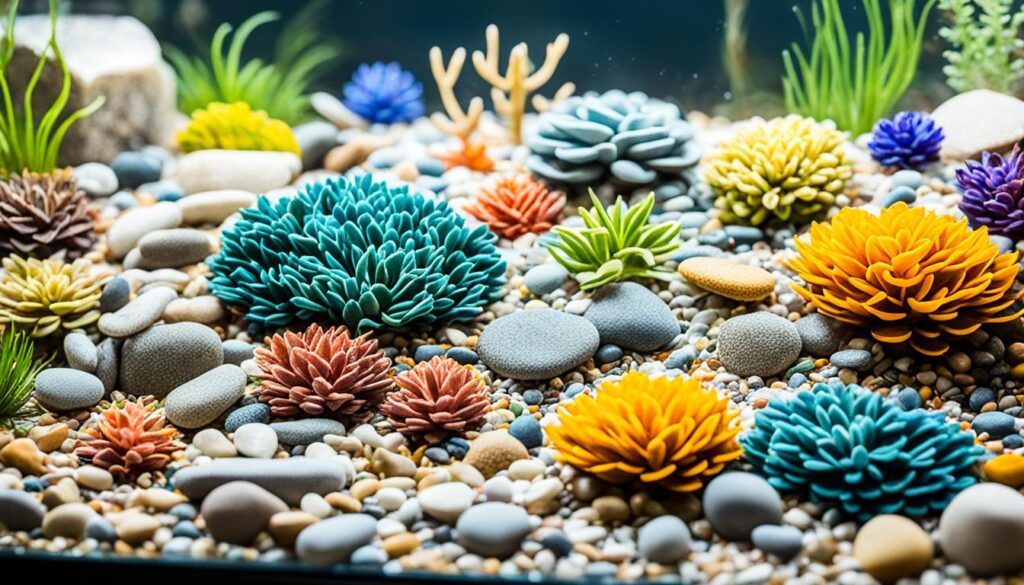
Using affordable substrate options not only helps you save money but also allows you to create a customized substrate mix that meets your aquarium’s needs. By exploring these alternatives, you can achieve a beautiful and thriving aquarium without breaking the bank.
Considerations for Choosing Substrate Size
The size of the substrate particles is a critical factor that directly affects plant growth and root development in freshwater aquariums. It is crucial to select a substrate size that promotes proper root penetration and establishment, ensuring optimal plant health and growth.
When considering substrate size, it is important to avoid very fine sand particles. Although they may appear visually appealing, fine sand tends to compact, creating a dense layer that restricts root penetration. This compaction makes it challenging for plant roots to spread and establish themselves, limiting their access to nutrients and water.
Instead, it is advisable to choose coarse sand for your aquarium substrate. Coarse sand particles create small pockets of space between them, allowing for better root penetration and growth. These pockets of space enable roots to spread and anchor more easily, facilitating nutrient and water uptake, which is essential for plant health and vitality.
While coarse sand promotes root development, it’s important to strike a balance and avoid the use of large river stones. Although river stones can create an interesting and natural aesthetic, they have too much empty space between them. This excess space makes it challenging for rooted plants to establish themselves, as they require a substrate that offers sufficient contact and support for root attachment and growth.
To summarize, choosing the right substrate size is crucial for promoting proper root development and plant establishment in your freshwater aquarium. Avoid very fine sand particles that compact and limit root penetration. Instead, opt for coarse sand that provides small pockets for roots to spread and anchor. While large river stones may be visually appealing, they do not offer the necessary support for rooted plants. By considering these factors, you can create an ideal substrate size that supports healthy plant growth and enhances the overall aesthetics of your aquarium.
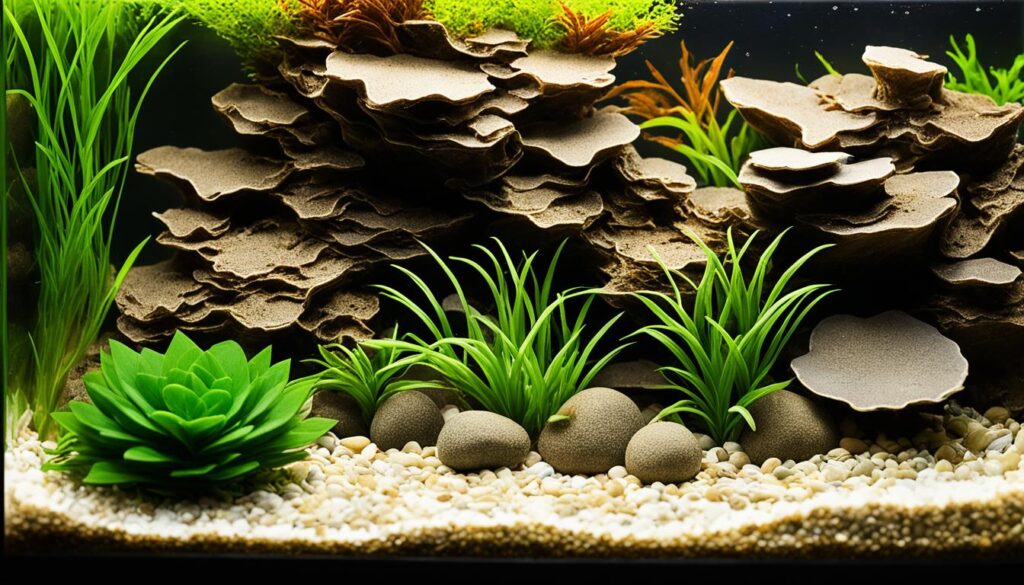
Personalizing Substrate Choices for Your Aquarium
When it comes to customizing substrate mixes for your freshwater aquarium, personalization is key. Each aquarium has its own unique water composition, and it’s crucial to consider this factor when selecting substrates. Just like in gardening, understanding the specific needs of your plants and the composition of your local water can greatly influence your substrate choices.
One way to personalize your substrate choices is by testing your water composition. This can help identify any deficiencies or imbalances in nutrients, pH levels, or water hardness. Armed with this information, you can select substrates that will help address these specific needs and create a healthier aquatic environment for your plants and fish.
I always test my water composition before making substrate decisions for my aquarium. It allows me to make informed choices and ensure that my plants have the necessary nutrients to thrive.
Another valuable resource for personalizing your substrate choices is the local planted tank community. Connecting with other aquarium hobbyists who have similar water composition can provide valuable insights and recommendations. They can share their own experiences and offer guidance on which substrates have worked best for their aquarium setups.
Additionally, it’s important to consider the plant preferences when selecting substrates. Different plant species have varying requirements in terms of substrate type, pH levels, and nutrient availability. Some plants prefer sandy substrates, while others thrive in gravel or clay-based substrates. By understanding the specific needs of your plants, you can choose substrates that will support their growth and overall well-being.
To find the best combination of substrates for your aquarium, don’t be afraid to experiment. Try different substrates and mixes to see which ones yield the best results. Observe how your plants respond and adjust accordingly. Customizing your substrate mix is a continuous process of learning and adaptation, and it’s part of the joy of owning an aquarium.
I’ve found that experimenting with different substrates has allowed me to create the optimal environment for my plants. It’s exciting to see how they respond and thrive in the customized substrate mix.
In conclusion, personalizing substrate choices is essential for creating a thriving and visually appealing freshwater aquarium. By considering factors such as local water composition, substrate testing, plant preferences, and insights from the planted tank community, you can find the perfect combination of substrates that works best for your specific setup. So go ahead, get creative, and make your aquarium a personalized oasis for your aquatic plants and fish.
Budget-Friendly Strategies for Substrate Customization
Substrate customization doesn’t have to break the bank when it comes to customizing substrate mixes for freshwater aquariums. There are budget-friendly strategies and cost-effective options available that allow aquarists to achieve their desired results without overspending on expensive nutrient-rich substrates.
Strategic Plant Selection
One of the key strategies for budget-friendly substrate customization is strategic plant selection. By choosing plants that don’t primarily feed from their roots, aquarists can save money on costly substrate options. Many aquatic plants can absorb nutrients through their leaves, stems, and water column. By incorporating these plants into your aquarium, you can minimize the need for nutrient-rich substrates.
Partial Substrate Mineralization
Instead of covering the entire tank with expensive substrate, consider mineralizing only the areas where root-feeding plants will be placed. This can be achieved by using root tabs or liquid fertilizers. By strategically placing these supplements in targeted areas, you can provide the necessary nutrients for root-feeding plants while using a more cost-effective substrate option, such as gravel or sand, as the base.
Cost-Effective Options
There are several cost-effective substrate options available that can help you achieve a customized substrate mix without overspending. Gravel and sand are popular choices that can provide a suitable foundation for planted aquariums. These options are often available at affordable prices and can be sourced from local pet stores, garden centers, or online retailers. By exploring different suppliers, you might find even more cost-effective options, such as pool filter sand or paver sand, which can be purchased at significantly lower prices from pool supply stores or home improvement stores.
| Substrate Option | Pros | Cons |
|---|---|---|
| Gravel |
|
|
| Sand |
|
|
Minimize Substrate Depth
Another budget-friendly strategy is to minimize the depth of your substrate layer. By reducing the overall thickness, you can save on the amount of substrate needed, resulting in cost savings. For most freshwater planted aquariums, a substrate depth of one to two inches is typically sufficient to support plant growth.
By utilizing these budget-friendly strategies and cost-effective options, you can achieve a customized substrate mix for your freshwater aquarium without stretching your budget. Remember to consider the specific needs of your plants and target areas where root-feeding plants will be placed. With some thoughtful planning and strategic choices, you can create a beautiful and thriving planted aquarium without breaking the bank.
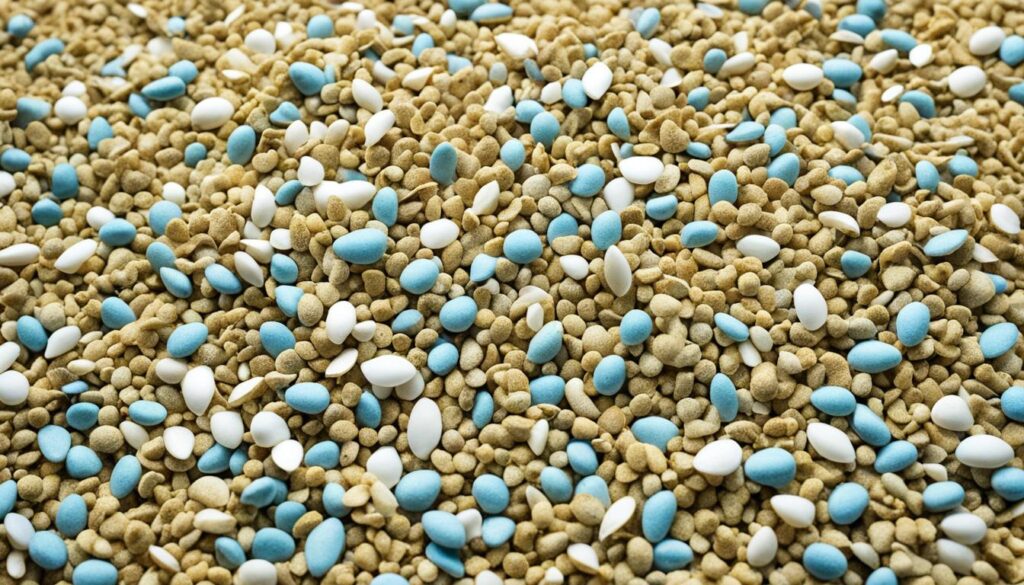
Next, we’ll conclude our guide to customizing ideal substrate mixes for freshwater aquariums and summarize the main points to optimize plant growth and achieve your desired aesthetic while considering cost considerations.
Conclusion
Customizing substrate mixes for freshwater aquariums is essential for optimizing plant growth and creating a healthy aquatic environment. When choosing between nutrient-rich and inert substrates, it is important to consider the specific needs of your plants and your budget. By mixing substrates and exploring alternative sourcing options, you can find cost-effective solutions without compromising plant health.
Factors like water composition, plant preferences, and strategic substrate selection should be taken into account when customizing your ideal substrate mix. This will promote optimal plant growth and enhance the overall aesthetic appeal of your aquarium. Whether you opt for nutrient-rich substrates or inert options like gravel or sand, with targeted nutrient supplementation, you can create the perfect environment for your plants to thrive.
In conclusion, by customizing substrate mixes, you can optimize plant growth, create a visually appealing aquarium, and save on costs. With the right substrate mix, your freshwater aquarium will not only be a beautiful display but also a thriving ecosystem for your aquatic plants.
FAQ
What is the purpose of substrate in a freshwater aquarium?
The substrate serves as a foundation for plants and decor, providing a medium for the plants to anchor their roots and absorb essential nutrients.
What are the main types of substrates for freshwater aquariums?
There are two main types of substrates: nutrient-rich and inert. Nutrient-rich substrates contain organic materials and provide essential nutrients for plant growth. Inert substrates, like gravel and sand, do not provide nutrients but can be used effectively with root tabs or liquid fertilizers.
Which substrate is best for planted tanks?
The choice of substrate depends on the specific needs of the plants you want to keep. Nutrient-rich substrates are beneficial for root-feeding plants, while inert substrates can be used for plants that primarily feed from the water.
What are the advantages of nutrient-rich substrates?
Nutrient-rich substrates provide essential nutrients for plant growth, lower pH, and soften water hardness. They are particularly beneficial for crystal shrimp tanks and aquariums with heavy root-feeding plants.
Are there any drawbacks to using nutrient-rich substrates?
Over time, nutrient-rich substrates can become depleted and require remineralization. They can also break down and become muddy, leading to cloudy water. Additionally, nutrient-rich substrates tend to be more expensive than inert substrates.
What are the benefits of using inert substrates?
Inert substrates do not provide nutrients but can still serve as a medium for anchoring plants and creating a visually appealing substrate. They do not break down over time and typically have a higher cation exchange capacity, allowing them to hold onto nutrients from fish waste or fertilizers.
Can I mix nutrient-rich and inert substrates?
Yes, mixing substrates allows for a more customized approach. By capping a nutrient-rich substrate with an inert substrate, you can create depth and slow the leaching of nutrients into the water column.
What are some cost-effective alternatives to expensive substrates?
Pool filter sand, paver sand, propagating sand, and rocks or gravel from garden centers can be sourced at a lower cost compared to pet stores. These options can be used as inert substrates to create a customized substrate mix.
How does substrate size impact plant growth in freshwater aquariums?
Very fine sand particles can compact, making it difficult for plant roots to penetrate. Coarse sand allows for better root penetration, while large river stones have too much empty space between them for rooted plants to establish themselves.
How can I personalize substrate choices for my aquarium?
Test your water composition to determine any deficiencies and find plants that have similar water preferences. Consider the specific needs of the plants you intend to keep and seek recommendations from local planted tank enthusiasts.
How can I customize my substrate mix on a budget?
Strategically select plants that do not primarily feed from their roots and target specific areas for nutrient supplementation. Use cost-effective options like gravel or sand for the majority of the tank and mineralize only the areas where root-feeding plants are located.
